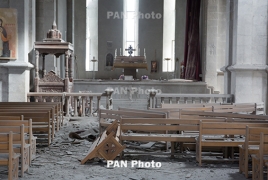
Azerbaijan has consistently demolished Armenian cultural heritage, including churches and monuments, in territories under its control. Following the 44-day war, this policy has intensified.
Recently, Azerbaijani vandals have continued destroying Armenian heritage in Nagorno-Karabakh, Armenpress reports.
In Shushi, the Holy Savior Cathedral (Ghazanchetsots) and the Green Church have been damaged. The Saint Sargis Church in Mokhrenis village, Hadrut, has been completely destroyed, and the Saint Harutyun Church in Berdzor has been converted into a mosque.
Under the directive of Azerbaijani authorities, Armenian historical monuments are systematically destroyed or misrepresented as non-Armenian. This mirrors the precedent in Nakhichevan, where Armenian churches, khachkars, and inscriptions have been entirely eradicated.
A recent act of vandalism involves the Vankasar Church in the Martakert region, where Azerbaijanis removed the cross from its dome, showcasing this act via the "Experience Azerbaijan" account.
In Tsar village, Karvachar region, Azerbaijani construction activities have compromised the structure of the Saint Sargis Church, with removal of khachkars and inscribed stones.
The monument on Andranik Street in Stepanakert has also been damaged.
In the Kashatagh region, north of Berdzor, Azerbaijanis have removed crosses from the Zorakhach Church, distorting historical heritage.
In Stepanakert, Azerbaijani forces have demolished monuments of Khachatur Abovyan, Hovhannes Baghramyan, Stepan Shaumyan, Alexander Myasnikyan, Alek Manukyan, and Ivan Isakov.
Azerbaijani authorities continue their state policy of vandalism, while the international community has yet to take effective measures to halt this process.
This situation requires documentation to enable relevant international bodies to pressure Azerbaijan to cease the systematic destruction of Armenian cultural heritage.
On September 19, 2023, Azerbaijan launched a large-scale attack on Artsakh, subjecting the country to massive shelling. As a result, on September 20, the authorities of the Republic of Artsakh accepted the Russian peacekeeping mission's proposal for a ceasefire, agreeing to Baku's terms, including the disarmament of the Defense Army and the dissolution of the Republic of Artsakh. Starting from September 24, forced displacement of Artsakh residents began, with over 100,000 people forcibly relocated to Armenia. According to some reports, about 20 Armenians remain in Artsakh. On September 28, President Samvel Shahramanyan signed a decree on the dissolution of the Republic of Artsakh, which came into effect on January 1, 2024.

